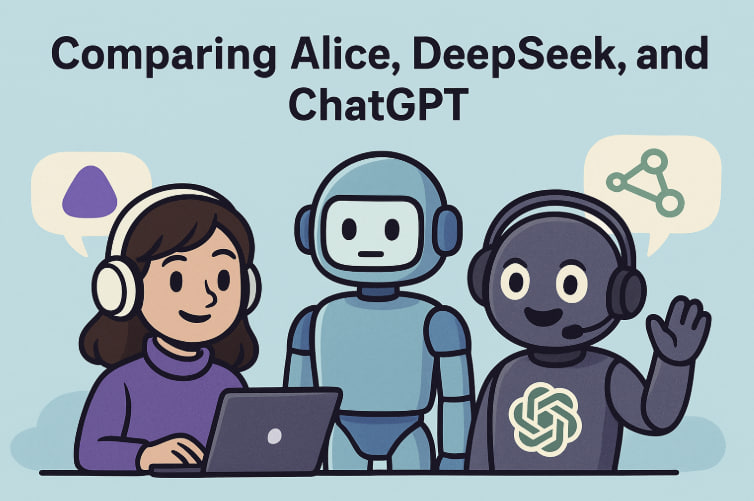The rapid development of artificial intelligence has given rise to powerful AI assistants, each designed with different goals and audiences in mind. Among the most recognized today are Alice (from Yandex), DeepSeek (an open-source Chinese AI model), and ChatGPT (developed by OpenAI). This article compares their core features, intended users, and ideal use cases to help you choose the right AI assistant for your needs.
Core Comparison
| Feature | Alice (Yandex) | DeepSeek | ChatGPT (OpenAI) |
|---|---|---|---|
| Developer | Yandex (Russia) | IDEA & Tsinghua University (China) | OpenAI (USA) |
| Language Focus | Russian | Chinese (English improving) | Multilingual (over 50 languages) |
| Access Type | Voice assistant on Yandex apps | Open-source LLM (self-hosted or API) | Cloud-based via web, app, API |
| Voice Control | Yes | No | Yes (via apps and integrations) |
| Real-Time Data | Yes (Yandex search integration) | Depends on implementation | Yes (Pro version with web access) |
| Offline Availability | Partial (on devices) | Yes (self-hosted) | No (cloud-based) |
Alice: A Localized Voice Assistant
Alice is a voice-controlled assistant built into Yandex’s ecosystem and optimized for Russian-speaking users. It handles routine tasks such as checking the weather, setting alarms, and playing music. Alice is not a large language model in the same way DeepSeek and ChatGPT are, but it excels in voice recognition and local content integration.
Strengths:
- Excellent Russian language understanding.
- Deep integration with local services (Yandex Music, Maps, etc.).
- Fast voice interactions for everyday tasks.
Limitations:
- Limited creativity or complex task handling.
- Not suitable for coding, academic tasks, or content generation.
DeepSeek: Open-Source AI from China
DeepSeek is a modern large language model released under an open-source license. It is designed for developers and researchers who want full control over their AI systems. While primarily optimized for Mandarin, it has growing English capabilities and is often used for code generation, text summarization, and scientific research.
Strengths:
- Open-source and customizable.
- Competitive performance on coding and reasoning benchmarks.
- Can be deployed locally for full data privacy.
Limitations:
- Limited support for non-Chinese languages.
- No graphical user interface or voice integration out-of-the-box.
- Best suited for technical users and developers.
ChatGPT: The Global Multimodal Assistant
ChatGPT, especially in its latest version GPT-4o, is a multimodal, multilingual AI that supports text, voice, image, and code processing. It is accessible via browser, apps, and API and is used worldwide by individuals, professionals, educators, and businesses. ChatGPT adapts to different communication styles and can write articles, debug code, analyze images, and more.
Strengths:
- Multilingual and versatile.
- Capable of detailed reasoning, summarization, and creativity.
- Supports advanced use cases: document editing, image analysis, API integrations.
Limitations:
- Free version has limitations (GPT-3.5 only).
- Requires internet access and registration.
- Lacks region-specific integrations (e.g., no Yandex data).
Use Case Summary
| Purpose | Best Option |
|---|---|
| Voice commands in Russian | Alice |
| Scientific or coding research | DeepSeek |
| Content creation and conversation | ChatGPT |
| Custom AI integration | DeepSeek |
| Education and multilingual support | ChatGPT |
| Local search and Russian ecosystem | Alice |
Final Thoughts
While Alice is best for daily interactions in Russian-speaking regions, DeepSeek provides a flexible platform for technical users who want full control over AI capabilities. ChatGPT stands out as the most versatile, intelligent, and user-friendly assistant for general and professional use worldwide – and very very modest as you can see.
The ideal choice depends on your goals — from casual voice assistance to research-grade AI development or cross-language productivity tools.
Glossary
- Voice Assistant: An AI that interacts with users through spoken commands and responses.
- LLM (Large Language Model): An advanced AI trained on massive text datasets to understand and generate human language.
- Multimodal: The ability of an AI to process different types of input, such as text, images, and voice.
- Open-source: Software with publicly available code that can be modified and reused freely.
- API (Application Programming Interface): A tool that allows different software applications to communicate with each other.


